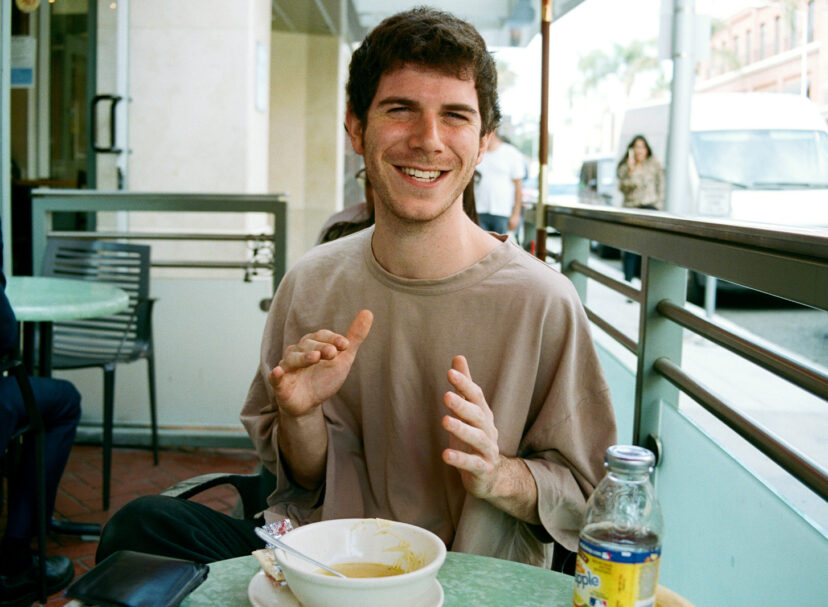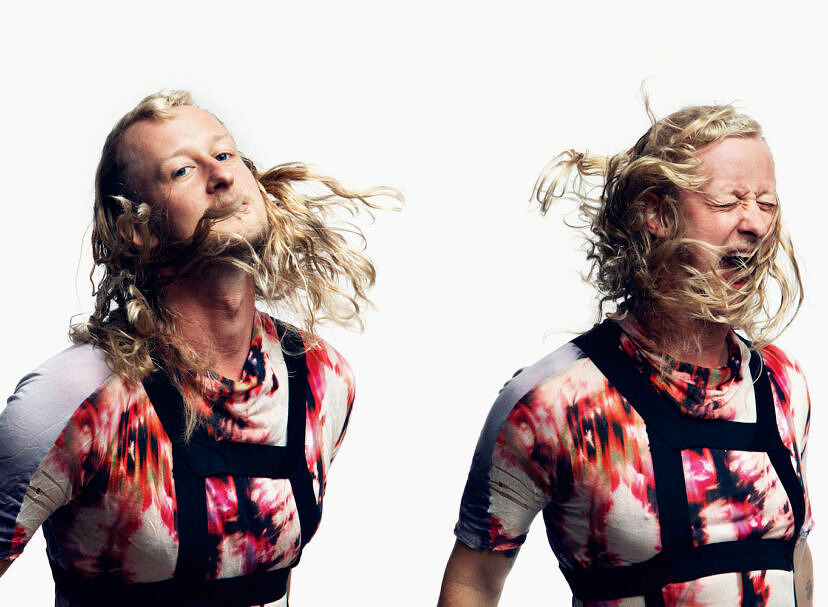Interview: Andy Fenwick
Cover Photo: Janie Hodges
Around two and half minutes into Kin Hana’s “Generations,” off new album Au Sable, what began as a gentle composition slips into a rolling, clashing refrain, all the more momentous for how easily you find yourself agreeing with the change in atmosphere. Au Sable works like this throughout. On the back of Kin Hana’s (Aaron Carroll Hodges) unfussy acoustic guitar and singing, songs tumble and stretch with cello, analog synths, and even sneaky field recordings. With with its late night AM radio sheen, production on the “The Mountain” evokes Bill Holt’s Dreamies (1974) or even 10CC. “Long Hair” offers a gorgeous, wordlessly sung figure over cello, something only repeated once, bookending a majestic, sprawling composition devoid of acoustic guitar.
But there’s more than guitar and voice songwriting at work here. Opener “Wernerchor” ranks as sound composition, something more likely to be conceived an experimental ambient artist.. In the deceptively straightforward acoustic jewel “You,” what works as a bridge is composed of exceptional sounds culled from field recordings. We asked Kina Hana about these mysterious noises and more
How did you make/what are the sounds on “Wernerchor?”
“Wernerchor” is made up of many layers of my voice and then slowed down digitally. I then edited the pieces of the choir to make it into a melody. The name references German painter Werner Knaupp, who allowed me to use his painting for the cover of the album.
Around two minutes into “You,” there’s what sounds like a field recording – what’s that?
That’s a combination of a few different recordings: one of the Pacific Ocean waves on Highway 1 in California (this is also mixed in very low on “Wernerchor”), a flute like instrument played in Vietnam, and a smattering of noises created from banging on a metal barrel I found in a barn (the latter two recordings are played in reverse).
“Long Hair” and “Generations” both open up into full orchestration; any more plans to do things that way? Is there any one track on Au Sable that you look back on and think, “That one, that’s the one where I want to do more like that.”
I have my amazing friend Kristen Drymala to thank for the orchestral work — she played all the cello parts on the record. There are plans to explore more orchestration, strings and otherwise, for sure. I listen back and feel the strongest connection to “Long Hair,” sonically — in its scope and size, and would like to do more of that kind of full bodied song-scape. Also releasing after Au Sable is a long track that embraces more of a deep, metal kind of sound hinted at in “Generations” and “Long Hair,” so there will be more of that sound to come as well.
What other non-analog, or unconventional analog, sounds are layered into the album? “Mountain” has a lovely, high, almost keening organ/key sound midway. What’s that?
That organ-like sound is actually a Roland SH-2 synthesizer, which is analog. It’s in every song on the record, excluding “Wernerchor.” “Generations,” as with “You,” features a collection of treated field recordings woven into the mix in certain sections: insects chirping in a field at night, the ferry bridge near my apartment in Brooklyn creaking as it moves in the water, and, though it was unintentional, there are some birds here and there cooing outside my bedroom window that snuck into the recordings.
Did you experiment or discover sounds *during* the recording, or did you have some/all ready to go? Specifically, “Johnny” features arp synths by Jim Smith – how did that develop?
My entire process is 99.9% discovery. he original husk of songs for this record was supposed to be as minimal as possible: just voice and guitar, but that concept died very quickly. For example. Jim (my dear friend who produced and engineered several of the songs) and I began laying deep percussive sounds onto “Long Hair” and that made me realize the song could get much bigger. So, I had Kristen come over and she and I figured out cello parts, which led to me thinking “Generations” needed to be bigger as well, so I started adding larger guitar sounds and drums to that as well. Jim was very involved in the arrangement discovery process and he also played all the drum/percussion parts. One night we were sitting in his house pouring over ideas for Johnny and he just started playing these amazing synth lines and they quickly became permanent features.
The title of the album – does it refer to anything/anywhere specific?
Au Sable refers to the town of Au Sable Forks, NY in the Adirondack Mountains (as well as to the Au Sable River of that region. In French ‘au sable’ means ‘in the sand’). This is where the real Kin Hana, my Japanese great-grandfather, eventually settled and made his life in America. So, the moniker and the name of the record are both family history references.
Is the Kin Hana name something to fit this project/music? Also – Is the Longshoreman name retired, or just another avenue, on pause? And, for our readers: what’s the origin of the Longshoreman name?
Kin Hana is a name originally decided upon for a heavier kind of music project I was starting to realize (referencing the song releasing shortly after Au Sable drops). But then I decided I just didn’t want to have two names and really liked Kin Hana. Currently I feel very married to it for whatever I make moving forward, so RIP Longshoreman (I think). I first saw the word longshoreman as a teenager when listening to a recording ethnomusicologist Alan Lomax made of a working song sung by Genoese longshoremen. I love the sea and enjoy nautical aesthetics associated with it, but more than anything I liked the sound of the word.

I listen back and feel the strongest connection to “Long Hair,” sonically — in its scope and size, and would like to do more of that kind of full bodied song-scape.

You’ve done a few residencies, and doing another one soon, if I’m not mistaken. What are the pros/cons for musicians when it comes to residencies?
Yes, I’ll be heading to the Millay Colony for the Arts in upstate NY this October. Residencies are mostly pros: free time and space to be creative and also take a breather from regular day to day work life. Just getting a residency I think is a huge boost to your artistic confidence. And the connections and community formed at residencies can provide inspiration and support during that period. The cons are few, really, but the main one I’d say is that my residencies have never felt long enough. Each time it’s been a month and in my experience it took about three weeks to really get into the creative flow state that a residency can set you up for. Seems I should apply to longer residencies!
I’ve read that you also act and dance – any current projects in those realms?
The dance work I’ve done in the past was a surprise thing that came about through my acting training/background and I really enjoyed it very much. I’m not sure when I’ll find my way back into dancing again, but I was taking an acting class earlier this year to re-explore that world. I may find myself in the audition room again soon, but right now I have no actual projects developing — Kin Hana seems to have most of my attention.
I also read that you moved often as a kid. Does that influence any of what you do? If so, how?
I’d say growing up an Army kid always moving from base to base is a huge part of why I am a creative person in general. There are a lot of adjustments children have to make when they’re relocating so frequently. In my case I think this gave me some psychic energies I’ve needed to deal with and being creative is a very healthy and direct way of doing so.


